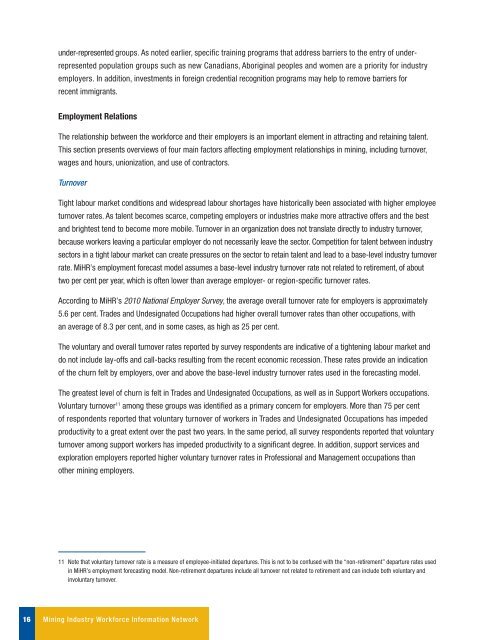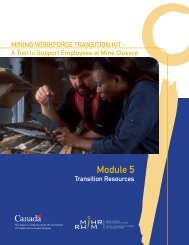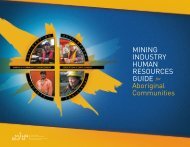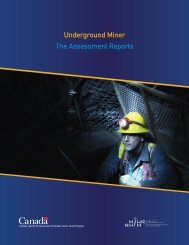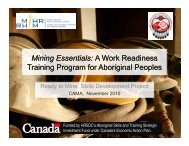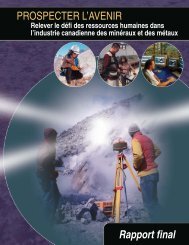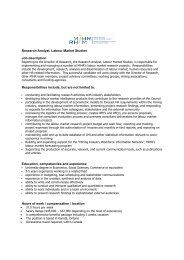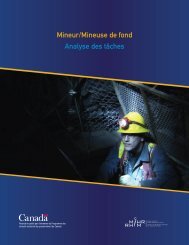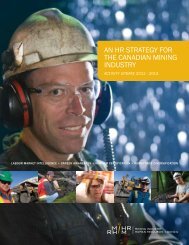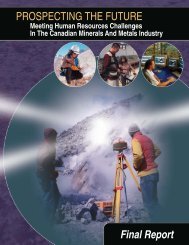Canadian Mining Industry Employment and Hiring Forecasts - MiHR
Canadian Mining Industry Employment and Hiring Forecasts - MiHR
Canadian Mining Industry Employment and Hiring Forecasts - MiHR
You also want an ePaper? Increase the reach of your titles
YUMPU automatically turns print PDFs into web optimized ePapers that Google loves.
under-represented groups. As noted earlier, specific training programs that address barriers to the entry of underrepresented<br />
population groups such as new <strong>Canadian</strong>s, Aboriginal peoples <strong>and</strong> women are a priority for industry<br />
employers. In addition, investments in foreign credential recognition programs may help to remove barriers for<br />
recent immigrants.<br />
<strong>Employment</strong> Relations<br />
The relationship between the workforce <strong>and</strong> their employers is an important element in attracting <strong>and</strong> retaining talent.<br />
This section presents overviews of four main factors affecting employment relationships in mining, including turnover,<br />
wages <strong>and</strong> hours, unionization, <strong>and</strong> use of contractors.<br />
Turnover<br />
Tight labour market conditions <strong>and</strong> widespread labour shortages have historically been associated with higher employee<br />
turnover rates. As talent becomes scarce, competing employers or industries make more attractive offers <strong>and</strong> the best<br />
<strong>and</strong> brightest tend to become more mobile. Turnover in an organization does not translate directly to industry turnover,<br />
because workers leaving a particular employer do not necessarily leave the sector. Competition for talent between industry<br />
sectors in a tight labour market can create pressures on the sector to retain talent <strong>and</strong> lead to a base-level industry turnover<br />
rate. <strong>MiHR</strong>’s employment forecast model assumes a base-level industry turnover rate not related to retirement, of about<br />
two per cent per year, which is often lower than average employer- or region-specific turnover rates.<br />
According to <strong>MiHR</strong>’s 2010 National Employer Survey, the average overall turnover rate for employers is approximately<br />
5.6 per cent. Trades <strong>and</strong> Undesignated Occupations had higher overall turnover rates than other occupations, with<br />
an average of 8.3 per cent, <strong>and</strong> in some cases, as high as 25 per cent.<br />
The voluntary <strong>and</strong> overall turnover rates reported by survey respondents are indicative of a tightening labour market <strong>and</strong><br />
do not include lay-offs <strong>and</strong> call-backs resulting from the recent economic recession. These rates provide an indication<br />
of the churn felt by employers, over <strong>and</strong> above the base-level industry turnover rates used in the forecasting model.<br />
The greatest level of churn is felt in Trades <strong>and</strong> Undesignated Occupations, as well as in Support Workers occupations.<br />
Voluntary turnover 11 among these groups was identified as a primary concern for employers. More than 75 per cent<br />
of respondents reported that voluntary turnover of workers in Trades <strong>and</strong> Undesignated Occupations has impeded<br />
productivity to a great extent over the past two years. In the same period, all survey respondents reported that voluntary<br />
turnover among support workers has impeded productivity to a significant degree. In addition, support services <strong>and</strong><br />
exploration employers reported higher voluntary turnover rates in Professional <strong>and</strong> Management occupations than<br />
other mining employers.<br />
11 Note that voluntary turnover rate is a measure of employee-initiated departures. This is not to be confused with the “non-retirement” departure rates used<br />
in <strong>MiHR</strong>’s employment forecasting model. Non-retirement departures include all turnover not related to retirement <strong>and</strong> can include both voluntary <strong>and</strong><br />
involuntary turnover.<br />
16 <strong>Mining</strong> <strong>Industry</strong> Workforce Information Network


